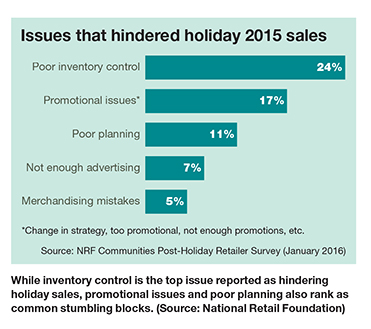Why Execution Needs Planning
In warehouses and DCs, planning solutions tend to take a back seat to execution system functions. Vendors are working to boost the trust factor using tools that break down forecasts and blend with analytics.
Warehouses and distribution centers are execution focused, no doubt about it. Execution solutions such as warehouse management systems (WMS) guide material moves and ensure the right quantities of the right goods remain in pick areas. The final pick, pack and ship processes are also typically governed by the WMS or a shipping solution.
But it is planning that sets the stage for effective execution. Everything from knowing the forecast by stock keeping unit (SKU) to calculating the optimal stocking levels across a DC network, down to managing how much warehouse labor is needed for a shift, is made more accurate by planning.
A 2016 survey by the National Retail Federation (NRF) found that the top three issues hindering holiday sales were poor inventory control, promotional issues, followed by poor planning. Clearly, effective fulfillment rests on an execution foundation, but in practice, requires planning as well.

“You can think of inventory management or planning as the strategy aspect, whereas inventory control is the execution,” says Michael Lovelace, director of business development for distribution solutions at Epicor Software. “You need that planning to happen first, just as if you were going to drive across the country, you would plan your routes and where you want to stay along the way.”
At a high level, says Lovelace, planning for distribution is about balancing the cost to carry inventory vs. the cost to serve and customer service targets. “Planning is about the optimum meeting point between cost to carry vs. the cost to serve,” he says.
There isn’t just one type of planning tool needed for supply chain execution, vendors say, or for that matter, one type of vendor to get them from. The landscape includes enterprise resources planning (ERP) vendors such as Epicor and others who also offer WMS and demand and supply planning modules, large supply chain execution (SCE) suite providers who offer planning, and best-of-breed forecasting and planning vendors.
Potential users of planning solutions need to be able to sort through the vendor landscape as well as grasp the different planning horizons and solutions and how they work together to refine forecasts into meaningful information for the warehouse. These solutions include demand-forecasting applications, and perhaps most important for DCs, inventory and replenishment planning tools that break down the inventory impact of demand plans and consumption patterns.
To the DC level
Planning paves the way for good execution, agrees Peter Schnorbach, senior director of product management for Manhattan Associates, a SCE suite provider. A complete platform for execution, he adds, should provide planning functions that work at various levels, from longer range inventory optimization across a DC network to replenishment planning for DCs to labor planning.
The organizations that tend to be the best at executing in the warehouse are the relatively few enterprises that have been able to bring both planning and execution together within a cohesive software platform, says Schnorbach. As part of Manhattan’s platform, there is a common data model for planning and execution, making it possible to easily feed replenishment plans into WMS or slotting.
The integrated approach to execution and planning, Schnorbach says, is there to be taken advantage of. “I don’t think companies integrate planning and execution as well as they could,” he says. “Some companies are better at it than others, but generally, it’s an area where we think there is lot of opportunity.”
Some Manhattan users have seen benefits from combining planning and execution within an integrated platform. For example, Pet Supplies Plus, a Livonia, Mich.-based specialty pet retailer with more than 300 company-operated and franchise outlets, deployed a suite of Manhattan Associates applications, starting with inventory optimization, followed by WMS and other solutions including labor management and slotting. The combination of applications (including planning) is credited with reducing DC inventory by 10%, improving turns, while also achieving an order fill rate of nearly 95% and exceeding service-level goals by nearly 2%.

A key link between corporate demand planning and warehouse-level execution is replenishment planning software, agrees Dan Grimm, vice president of solutions strategy with JDA Software, a SCE suite provider. Within JDA’s lineup, replenishment planning is called “fulfillment” planning, and like most replenishment tools, it breaks down a demand plan into what will be needed at each DC and when. “The more granular, real-time information I can provide to the execution teams, the better they can prepare for whatever is going to come at them,” says Grimm.
The challenge of linking planning with execution is two-fold, adds Grimm. “One part of the challenge is to provide network visibility in real time from the execution systems up to the planning tools so that the planners have the right data to make decision with,” he says. “Second, there is the challenge that there may be different departments doing planning, using different software tools, and they don’t really communicate.”
The solution, says Grimm, is to use integrated planning tools that can translate demand plans into detailed inventory and replenishment plans relevant to DC operations, while also being able to feed execution-level constraints, such as the number of people or dock doors available at DCs, back up to planning.
“If from the execution side I’m able to pass back to the planning tools constraints such as, ‘here is how many people the warehouse will have that day,’ or, ‘here is how much available space I have,’ then the planning tools can do a better job in the first place because they aren’t generating plans in a vacuum,” Grimm says. “They are taking into consideration real-world constraints.”
Epicor’s Lovelace agrees that from a DC perspective, plans need to reach down into optimal stocking levels by site and SKU to be relevant. “You need both a holistic view of plans as well as deep-dive view,” he says.
Balancing priorities
While planning can help a DC network right-size inventory levels to reduce carrying costs, good planning also has a customer service benefit, says Michael Wohlwend, Americas general manager for Iptor, an ERP and WMS provider. Many of Iptor’s customers are distributors, and as such, can deliver value by helping customers better understand demand, he says.
“In a wholesale distribution environment, demand planning is really about working with your customers, understanding their demands, and then matching that up with your suppliers,” says Wohlwend.
Iptor offers demand planning and supply planning tools that can break inventory needs down the SKU level, says Wohlwend. The vendor also offers a module called Planner View that lets planners see demand plans and supply details in one user interface. “It’s about having detailed insights so that you can minimize out of stocks and increase turns,” he says.
One of Iptor’s customer’s, adds Wohlwend, even takes point-of-sale (POS) data from one of its key customers and analyzes the data against internal demand and supply plans to arrive at the best stock levels for each of that customer’s store locations. “They are coming back to the customer and saying, ‘Hey, you need this many more units of this item to minimize out of stock at these locations,’” he says. “So, they are adding value for their customer using demand and supply planning tools.”
While traditional planning applications can address inventory levels in a DC or even multiple DCs, some vendors have targeted the need to optimize inventory across an entire value chain, including raw materials held upstream by suppliers, work-in-process inventory in plants or at contract manufacturers sites, as well as SKUs in DCs. Known as multi-echelon planning, this type of planning is used by some companies to complement the more traditional tools, says Henry Canitz, product director with Logility, which offers multi-echelon capability.
“Multi-echelon inventory optimization not only allows you to optimize at the individual node—it allows you to look at the different types of inventory,” Canitz says. “For instance, does it make sense to hold onto a certain level of raw materials, or work-in-process materials, so you can respond very quickly to demand vs. only optimizing around finished-goods inventory, which might limit your flexibility. The goal is to minimize total network inventory while meeting the customer service level.”
For DC networks, adds Canitz, planning might reveal that the best approach is to create a site that serves as a regional inventory buffer for multiple DCs. “That may give you the flexibility to move goods very quickly into a market that needs it vs. planning buffers at every DC and carrying significantly more inventory,” he says.
In the past, warehouse managers often didn’t see corporate forecasts as realistic because they were more rigid and based on historical sales data that didn’t end up matching what would really be needed for fulfillment at each warehouse, says Vikash Goyal, senior director of product strategy with Oracle, an ERP and supply chain solution vendor. But planning tools now can look at sales and consumer-buying trends at a local level, at regional weather trends, and at supply chain events, he says, and then can quickly refine plans based on changing information. “The number of signals planning can take in and the real-time nature of those signals has significantly improved, so now planning can be more demand driven,” says Goyal.
Integrating it all
The traditional gulf between planning and execution applications is closing, says Goyal, in part because of better analytical tools that work with the planning engines and can also examine inventory and other current transactional data in ERP or WMS solutions. “In the modern planning system, there are none of those prior boundaries,” he says. “Planning systems are heavily analytical. They sense information more frequently and can be used to evaluate if something needs to change.”
When it comes using planning tools that sit closer to warehouse execution, such as labor planning and slotting, some vendors contend that having the planning apps in sync with the data model for WMS helps end-user organizations execute more effectively.
Not only does planning and execution within a suite remove the integration burden, the integrated suite approach ensures the output of plans blend fully with the WMS workflows, says Jon Kuerschner, vice president of product management and consulting at HighJump Software, a SCE suite provider.
“We see labor management, labor planning, slotting and WMS processes as being very much intertwined,” Kuerschner says. “The best way you can execute a plan is if you are fully integrated with the WMS.”
Good execution solutions, such as WMS that supports electronic data interchange, as well as application programing that interfaces with ERP or trading partner systems, are still needed to be ready to execute and make tactical plans around warehouse labor, says Iptor’s Wohlwend, but having integrated planning tools that can analyze demand, supply, and financial impacts in one place helps ensure the right inventory is in place without running up costs.
“On the wholesale distribution side, absolutely, planning is as important as execution,” Wohlwend says. “It’s about making sure you have the right products in the right place and at the right time for your customers.”
Companies mentioned in this article:
Epicor Software
HighJump Software
Iptor
JDA Software
Logility
Manhattan Associates
Oracle

Article Topics
Software News & Resources
C-suite Interview with Keith Moore, CEO, AutoScheduler.AI: MODEX was a meeting place for innovation C-Suite Interview with Frank Jewell of Datex, Leading the Way in the Material Handling Industry Give your warehouse management systems (WMS) a boost Agility Robotics and Manhattan Associates partner to bring AI-powered humanoid robots into warehouses Siemens, Universal Robots, and Zivid partner to unveil smart robotic picking solution OTTO Motors showcases latest software release for optimizing floor space Rite-Hite ONE digital platform debuts More SoftwareLatest in Materials Handling
Registration open for Pack Expo International 2024 Walmart chooses Swisslog AS/RS and software for third milk processing facility NetLogistik partners with Vuzix subsidiary Moviynt to offer mobility solutions for warehouses Materials Handling Robotics: The new world of heterogeneous robotic integration Lucas Watson appointed CSO for Körber’s Parcel Logistics business in North America Hyster recognizes Dealers of Distinction for 2023 Carolina Handling names Joe Perkins as COO More Materials HandlingAbout the Author
Subscribe to Materials Handling Magazine

Find out what the world's most innovative companies are doing to improve productivity in their plants and distribution centers.
Start your FREE subscription today.
April 2024 Modern Materials Handling

Latest Resources












